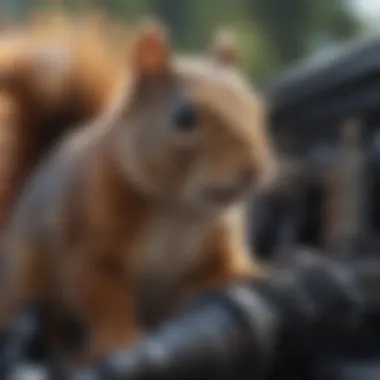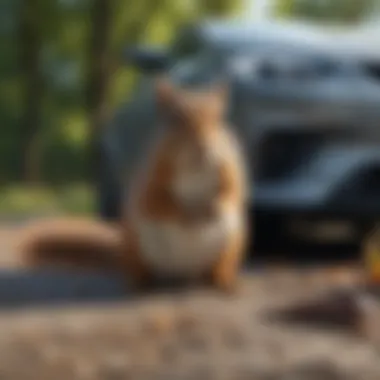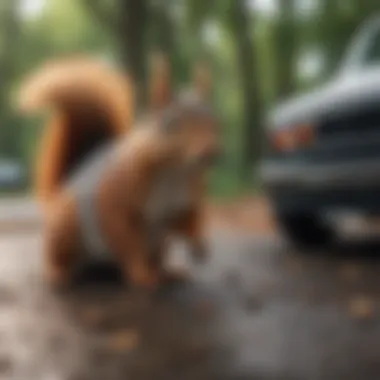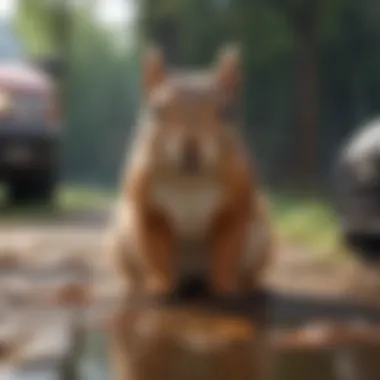Effective Strategies for Removing Squirrels from Your Car Engine


Intro
Squirrels can be more than just quaint residents of the outdoors; they can pose a significant threat to your car engine. Their behaviors and habits lead them to seek shelter or food in unexpected places, including the within the cozy compartments of your vehicle's engine. This guide provides a detailed exploration of the effective methods needed to eliminate these pests from your vehicle. As a vehicle owner, understanding your adversary is the first step toward prevention and resolution.
Understanding squirrel behavior is critical. They love to gnaw and often tear easily at wiring, making a nest out of the insulating material in your engine. This behavior can lead to costly damage and repair needs. Noticing signs of squirrels in your car is essential, as there may be indicators such as unusual noises and debris left behind.
The repercussions of ignoring squirrel presence cannot be understated. Damage can include frayed wiring and compromised components, affecting your car's efficiency and safety. Please continue to read for insight into both removal techniques and preventive strategies.
Main Points of Discussion
- Importance of recognizing squirrel habits and signs.
- Methods for deterring squirrels and animal-proofing vehicles.
- Strategies for repair or damage mitigation, should infestations occur.
- Long-term solutions for preventing unwanted critters.
This guide aims to provide a practical approach for individuals facing the challenge of squirrels in their car engines, combining immediate action steps with preventive practices. Let us move to the first phase of dealing with unwanted furry visitors before they wreak havoc on your automobile.
Understanding Squirrel Behavior and Attraction to Vehicles
Understanding the behavior of squirrels and their attraction to vehicles lays the ground for addressing the issue of their presence in car engines effectively. By diving into their instincts, preferences, and the circumstances that appeal to them regarding vehicles, car owners can develop tailored strategies for prevention and removal. This knowledge is crucial, as it sheds light on the best practices that can be adopted.
The Natural Instincts of Squirrels
Squirrels possess distinct natural instincts that shape their behavior. They are foraging animals and primarily seek food and shelter to survive. This need drives them to explore environments that provide such resources.
- Foraging: Squirrels often search for foods like nuts and seeds, which leads them to park areas, gardens, and, sometimes, vehicles parked under trees that may have acorns or other edibles.
- Nesting: When squirrels find a secure hiding spot, they may take interest in that area to create nests. Engine compartments can seem safe and cozy for them. The warmth of the vehicle, especially in colder seasons, adds to its attractive qualities.
- Curiosity: Their natural curiosity further pushes them to explore new spaces. Squirrels engage about finding fun places to investigate, contributing to their occasional discomfort with vehicles. Thus, understanding these instincts clarifies how cars can become a target for habitation.
Why Cars Are Appealing to Squirrels
Cars exhibit features that can attract squirrels in various opportunistic ways. They offer shelter, warmth, and potential resources that align perfectly with a squirrel’s needs.
- Warmth: The heat generated by the engine after a drive creates a pleasant environment for squirrels, especially in winter months. This warmth can be tempting for the animal seeking a place to shelter.
- Accessibility: Many cars park in areas where trees are present. This close proximity allows easier access to the vehicle, amplifying chances for squirrels. It reduces the effort they need to address food needs and facilitates nesting opportunities.
- Urgent Innovation: Oddly structured, some components of vehicles, such as the wiring or insulation, may appear interesting as squirrels investigate the unknown. These factors bolster why some vehicles become transient homes.
Impact of Seasonal Changes on Squirrel Activity
Seasonal changes influence squirrel behaviors, including their drive to find shelter and forage effectively. Each season brings varying motivations that can lead to an uptick on vehicle interest:
- Autumn: As trees shed leaves, sudden foraging intensifies. Squirrels look for places to hide food for winter. This need could lead them to cover parking areas beneath trees.
- Winter: Hibernation instinct prompts more scavenging efforts. The appeal of a warm car engine rises considerably. Cars parked in areas offering immediate tree access provide both shelter and accessibility during harsh weather.
- Spring and Summer: Do lend themselves providing breeding environments and nests. When young squirrels emerge, utility within vehicle engines becomes one of the many routes they explore for nesting opportunities.
Recognizing Signs of Squirrel Presence


Understanding when squirrels have invaded a vehicle is crucial for many reasons. Squirrels, while generally harmless, can create serious damage to both the electrical surge and insulation materials in cars. Initial signs of squirrel presence can help in early intervention strategies, saving car owners from significant repairs later on. Recognizing these signs early ensures that one can act swiftly.
Common Symptoms of Infestation
Spotting signs of a squirrel infestation is not always straightforward. However, the following indicators typically signal that squirrels have made their way into a vehicle:
- Nests: Squirrels often create nests in engine compartments. Such nests may consist of leaves, twigs, and fur. Check under the hood and around the battery for signs.
- Droppings: You may find small pellets, which can be a clear indication of squirrels. These can often be seen near car tires or undercarriage.
- Chewing Marks: Squirrels gnaw on various materials, and this behaviour can leave obvious distinct chew marks on wires, plastic parts, and hoses.
- Sounds: Unusual noises like scratching or scurrying may be heard when the engine is off, indicating movement inside the vehicle.
Properly using your senses and undertaking regular inspections are key parts of identifying a squirrel problem. By staying vigilant, car owners can take proactive steps against potential invasions.
Damage Assessment: What to Look For
Once signs indicating a possible squirrel presence have been recognized, the next critical step involves assessing the damage. Knowing what to inspect ensures a thorough examination and helps determine the severity of the problem:
- Wiring Damage: Look closely at all wires, especially those leading to the spark plugs. Squirrel teeth can easily fray and expose underlying wires, leading to electrical issues.
- Insulation Rubbed Off: Inspect the insulation around various components. Squirrels may tear or chew the material, resulting in exposed equipment.
- Debris Clutter: The presence of nesting materials not only indicate squirrel habitation but can also obstruct mechanical components, which may lead to further vehicle malfunctions.
By carefully assessing these areas within your vehicle, you can quantify the damage and mobilize the necessary actions to rectify it. Such damages can lead to inconvenient problems, including overheating issues and electrical failures.
"Hasty interference allows guardian cars to remain pristine and function flawlessly, a small but ou fighting chance against tickets from negligence."
In summary, acutely noticing and inspecting your vehicle for signs of squirrel presence will make for a significant step in ensuring its longevity and efficiency. Awareness today reduces potential headaches in the future.
Effective Techniques for Removal
Eliminating squirrels from a car engine goes beyond haphazardly chasing them away; it requires an informed and strategic approach. This section addresses practical techniques that yield positive results. Employing these methods ensures not only the immediate removal of the nuisance but also the prevention of their re-invasion. Additionally, understanding the nuances of each technique allows individuals to tailor their approach based on their unique situations and preferences.
Physical Removal Methods
Physical removal encompasses actions that directly oust squirrels from your vehicle. This approach may involve opening the hood and coaxing squirrels out if they’ve made themselves too cozy. However, it’s essential to exercise caution. Typically, squirrels may become agitated easily. Gently using methods can lower risks of injury to both the animal and yourself. Begin by offering nutritious food at a distance from the vehicle. When a squirrel approaches, try to engage in peaceful actions to entice it away. Always consider humane techniques that promote welfare alongside results.
Make sure the following points are adhered to during physical removal:
- Identify the areas where squirrels are nested.
- Use appropriate tools, such as ropes or nets, ensuring not to harm the animal.
- Exercise patience to let nature take its course if necessary, avoiding aggressive actions.
Using Natural Repellents
Exploring natural repellents offers a simple yet effective option. These substances can intervene in keeping squirrels at bay with minimal ecological impact. Common natural repellents include solutions like peppermint oil, cayenne pepper, and vinegar.
You can proceed as follows:


- Peppermint Oil: Distill peppermint oil in water and spray around the vehicle. Its strong scent is often off-putting for squirrels.
- Cayenne Pepper: A sprinkle around relevant locations may deter them from making a return visit. Its irritation to the senses prompts squirrels to avoid treated areas.
- Vinegar: Use water-vinegar solution and apply to materials that are easy to access within and around your vehicle.
This proactive step is often viewed as an environmentally friendly alternative without relying on harsh chemicals. Though results might vary, it is a method esteemed for offering high welfare standards for wildlife.
Electronic Deterrents and Traps
Utilizing electronic methods adds another layer to your squirrel removal toolkit. Devices designed with deterrence capabilities can offer consistent results without necessitating constant monitoring.
Popular electronic deterrents include:
- Ultrasonic Repellents: Produce high-frequency sounds, undesirable for squirrels. These noises usually remain inaudible for humans, allowing everyday car usage without disturbances.
- Motion-Activated Sprinklers: These clever devices deliver sudden bursts of water that frighten off unwelcome visitors.
When conventional techniques differ across situations, applying acoustic, visual, or sensory pressures will furnish a diverse approach gaining efficacy in varying contexts. Moving ahead with caution when using traps—ensuring no undue harm to the animals—remains crucial.
Consider integrating multiple removal techniques. Sometimes, a composite approach is necessary to retain results consistently.
In sum, the physical removal processes, natural repellents, and electronic methods provide distinct yet effective techniques tailored for occupied vehicles. Understanding their attributes aids in formulating a personalized strategy, ensuring that individuals engage in proper pest management. Each method embraces the fundamental values of safety, welfare, and effectiveness to remove the persistent annoyance of squirrels altogether.
Preventive Measures to Deter Squirrels
The topic of preventive measures is critical in addressing the issue of squirrels in car engines. By implementing effective strategies, individuals can significantly reduce the likelihood of infestation and subsequent vehicle damage. Preventive measures not only save money and hassle but also maintain the overall condition of the vehicle. Understanding the behavior of squirrels can help guide these measures, making it essential for car enthusiasts and owners alike to take proactive steps.
Regular Car Maintenance and Inspection
Maintenance may seem mundane, but it plays a vital role in keeping squirrels at bay. Regular car checks are essential. Ensure to open the hood and inspect the engine compartment periodically. Here are some important maintenance tips:
- Look for nests: Make it a routine to check under hoods for any signs of nesting or debris. Squirrels like to use insulation as nesting material.
- Clean areas: Removing leaves, twigs, or any visible debris can reduce attraction for squirrels. A cluttered engine may invite wildlife.
- Engine cover: Consider installing an engine cover or shield. Some types act as a barrier to discourage access.
In essence, an attentive approach to maintenance can create an unwelcoming space for squirrels.
Creating a Less Appealing Environment
The environment around a vehicle often plays a pivotal role in attracting or deterring squirrels. Several factors influence this relationship. By altering your surroundings, you reduce the chances of infestations:
- Plant placement: Evaluate the area for nearby trees or bushes. Keeping branches trimmed and away from the vehicle minimizes easy access for squirrels.
- Food sources: Remove bird feeders or secure trash bins tightly. Accessible food attracts not only squirrels but other wildlife as well, which can lead to compounded issues.
- Parking position: Avoid parking under tree canopies or near dense vegetation. A clear space around your vehicle lessens the chances of a squirrel choosing it as a nesting site.
A little effort in maintaining a clean and less inviting area can greatly positively influence the presence of squirrels around your vehicle.
Alternative Solutions for Persistent Issues


Dealing with squirrels in your car engine can often be a frustrating experience. While preventive measures are effective in reducing the chances of an infestation, some cars may face persistent issues despite these efforts. Thus, it becomes essential to explore alternative solutions. These methods not only target immediate problems but also offer long-lasting strategies against future occurrences. Consulting experts and adhering to legal regulations are two key components of this section.
Consulting Professional Pest Control
Professional pest control specialists possess deep knowledge about the behavior of squirrels and effective removal methods. When dealing with a chronic squirrel problem, enlisting the help of an expert can save time and prevent further damage to your vehicle. These professionals evaluate the situation impartially and develop tailored strategies specific to your needs. They can also implement exclusion techniques to prevent squirrels from returning to the car engine in the future.
"Hiring a professional can cease ongoing infestations, protecting your investment and peace of mind."
Choosing a pest control service entails considering a few factors:
- Experience: Look for professionals who specialize in wildlife removal and have a proven track record of successful squirrel control.
- Assessment: Seek experts that conduct a comprehensive assessment of your vehicle and its surroundings to inform their removal approach.
- Methods Employed: It’s also beneficial to inquire about their removal techniques to ensure they align with your values on animal welfare and humane treatment.
With the guidance of these professionals, you can effectively tackle a persistent squirrel problem, ultimately leading to a smoother vehicular experience.
Legal Regulations Regarding Wildlife Removal
When exploring alternatives for managing squirrels, it is vital to adhere to local legal regulations concerning wildlife. In many regions, squirrels are protected species. Consequently, any removal efforts must comply with state, provincial, or municipal laws to avoid legal repercussions.
Understanding the legal context is crucial, and this involves:
- Research Local Regulations: Different areas have varying rules about trapping and removing wildlife. Familiarizing yourself with relevant statutes helps in determining which removal strategies are permissible.
- Permits for Wildlife Control: In cases where removal techniques include trapping, obtaining the necessary permits may be required by law. Check with local wildlife agencies about its legalities.
- Humane Removal Practices: Align your methods with humane standards to ensure compliance and instrument a thorough understanding of ethical issues involved in wildlife removal.
Failing to understand these regulations can lead to fines or penalties. Furthermore, it may necessitate hiring qualified services that follow legal guidelines. Therefore, ensuring compliance is an indispensable part of any long-term strategy toward dealing with nuisances in your car engine.
Culmination: Strategies for a Squirrel-Free Vehicle
In the context of this article, the conclusion underscores essential tactics for maintaining a squirrel-free vehicle. As urbanization progresses, the risks posed by squirrel intrusions have become more notable. Implementing sustainable strategies carries immediate benefits, such as protecting both your vehicle and pocketbook from potential damages incurred by these creatures.
Promoting awareness regarding the significance of preemptive measures allows car owners to spare themselves from unexpected visits by squirrels into their engine compartment. Adopting a systematic approach firstly demands recognizing the squirrel behavior, followed by deploying effective resistance tactics to make your car undesirable to these animals.
Summarizing the Key Points
- Understanding Squirrels: Familiarizing with the behavioral patterns of these animals aids in managing encounters. Their instincts drive them to seek warmth and shelter in confined spaces like car engines.
- Detection: Identifying signs of squirrel activities early can prevent escalation. Look for chew marks, nests, and droppings.
- Removal Procedures: Available techniques for squirrel extraction from engines can range from humane traps to more holistic methods, including natural repellents that steer them away.
- Preventive Measures: A well-maintained car is considerably less attractive. Removing food sources from nearby environments lowers the chances of attracting squirrels.
- Long-Term Strategies: Healthier long-term relationships between car owners and their vehicles can be established through routine inspection and awareness.
Correspondingly,
A sound management plan necessitates active involvement. Individuals must engage in regular checkups and continually monitor landscape changes around their vehicle. Draw the line between your space and that of local wildlife.
Developing a Long-Term Management Plan
A robust long-term management plan remains crucial in keeping your car clear of squirrel interference. It begins with consistent engagements both inside and outside the vehicle area. Consider developing a checklist:
- Regular Inspections: Monthly checks ensure that no nests have formed around the battery or engine.
- Environmental Maintenance: Trimming nearby tree branches can restrict squirrels' access to vehicles. Look for existing pathways that might encourage intrusion.
- Food Source Elimination: Store trash bins enclosed and practice proper waste disposal.
- Community Awareness: Engage others in your neighborhood about these measures, fostering a united front against wildlife mismanagement.
Being proactive establishes a responsive network all aimed toward enthusiasm and security surrounding automobile possessions. Developing these systematic approaches not only safeguards your vehicle but also supports wider environmental harmony with local wildlife, allowing for coexistence without undue conflict.







